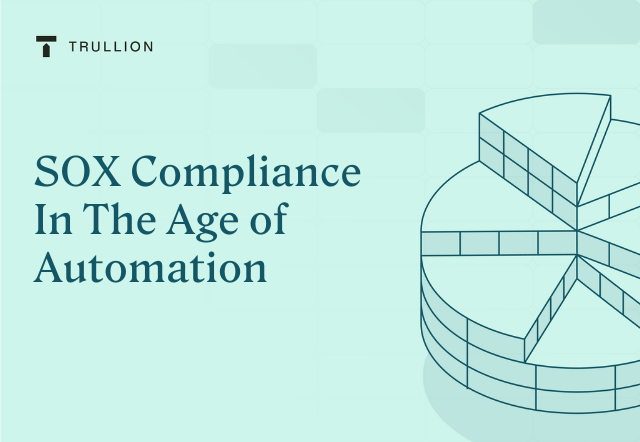As business gets more complex, faster-paced, and globally interconnected, maintaining transparency and trust in corporate governance and financial reporting becomes more critical than ever.
One crucial aspect that ensures the integrity of financial reporting and governance is compliance with the Sarbanes-Oxley Act, commonly known as SOX. Enacted in 2002, SOX was a direct response to major corporate scandals that shook the financial landscape, such as Enron and WorldCom. This landmark legislation aimed to restore investor confidence and establish strict standards for financial transparency and accountability.
SOX compliance is not just a legal requirement; it has become a cornerstone of responsible business practices. We’ll look at the intricacies of SOX compliance, its importance in financial reporting, and how organizations can achieve and maintain compliance.
Understanding the Sarbanes-Oxley Act (SOX)
To get a deeper understanding of the Act, it’s important to understand its roots, key provisions, and impact on financial reporting and corporate governance.
Background and History of the SOX Legislation
The Sarbanes-Oxley Act, named after its primary sponsors, Senator Paul Sarbanes and Representative Michael Oxley, was signed into law on July 30, 2002, by President George W. Bush. The Act was a direct response to a series of high-profile corporate scandals that highlighted the need for stronger regulations.
The collapse of Enron in 2001, followed by similar revelations surrounding WorldCom and other notable companies, exposed widespread accounting fraud, mismanagement, and inadequate internal controls. These scandals not only resulted in massive financial losses for investors but also eroded trust in the integrity of corporate reporting.
Key Provisions and Requirements of SOX
SOX introduced a comprehensive set of regulations and standards designed to enhance the accuracy, transparency, and reliability of financial reporting within publicly traded companies. The Act consists of multiple sections, each addressing specific aspects of corporate governance, financial disclosures, internal controls, and auditor independence. Key provisions include:
Section 302: This section mandates that the CEO and CFO of a publicly traded company must personally certify the accuracy and completeness of their company’s financial statements. They are responsible for establishing and maintaining internal controls to ensure reliable financial reporting.
Section 404: Arguably the most significant and resource-intensive provision, SOX 404 compliance requires companies to assess and report on the effectiveness of their internal controls over financial reporting. This includes identifying and evaluating potential risks, implementing control procedures, and obtaining annual external audits of these controls.
Section 409: This section requires companies to promptly disclose material changes in their financial condition or operations to ensure timely and accurate dissemination of relevant information to investors and the public.
Section 802: SOX established severe penalties for altering, destroying, or falsifying records or impeding investigations. It increased criminal penalties for fraudulent financial activities and imposed strict regulations on document retention and retention policies.
The Impact of SOX on Corporate Governance and Accountability
SOX has had a profound impact on corporate governance and accountability since its enactment. It has compelled companies to strengthen their internal control frameworks, adopt more rigorous financial reporting practices, and improve the quality of their audits. Some notable impacts of SOX include:
- Enhanced Transparency and Accountability: SOX has significantly increased the transparency of financial reporting by demanding more comprehensive and accurate disclosures. Companies are now required to provide a detailed analysis of their internal control systems, reducing the likelihood of fraudulent activities going undetected.
- Strengthened Internal Controls: The Act has prompted companies to establish robust internal control mechanisms to ensure the accuracy and reliability of their financial statements. This focus on internal controls has helped prevent errors and fraudulent activities, leading to more trustworthy financial reporting.
- Independent Auditing: SOX has enhanced the independence and accountability of external auditors by imposing restrictions on their non-audit services and strengthening their oversight. This has reduced potential conflicts of interest and ensured that auditors maintain an objective and impartial stance.
- Investor Confidence and Market Stability: By holding corporate executives accountable for the accuracy of financial statements, SOX has helped restore investor confidence in the integrity of financial markets. The Act has played a crucial role in promoting market stability and fostering a climate of trust and credibility.
Scope and Applicability of SOX Compliance
What is SOX compliance? SOX applies to publicly traded companies that are registered with the Securities and Exchange Commission (SEC) in the United States. This includes domestic and foreign companies whose shares are traded on U.S. stock exchanges or over-the-counter markets.
SOX Compliance Requirements for Public Companies
Public companies subject to SOX compliance must fulfill several requirements to ensure adherence to the Act. Some key SOX compliance requirements include:
- Financial Reporting and Internal Controls: Public companies are required to establish and maintain effective internal controls over financial reporting (ICFR) to provide reasonable assurance regarding the reliability of financial statements. This includes documenting, assessing, and testing internal controls to ensure their effectiveness and accuracy.
- CEO and CFO Certifications: As noted previously, the CEO and CFO of public companies must personally certify the accuracy and completeness of financial statements. They are responsible for establishing and maintaining internal controls, disclosing any significant deficiencies, and reporting changes to ICFR.
- Independent Audit Committee: SOX mandates that public companies have an independent audit committee composed of board members who are not involved in the day-to-day operations of the company. The committee oversees the financial reporting process, the appointment and independence of external auditors, and the implementation of internal controls.
Compliance Obligations for Executives, Auditors, and Directors
SOX places specific compliance obligations on executives, auditors, and directors to strengthen corporate governance and accountability. These obligations include:
- Executives: Not only do CEOs and CFOs have a personal responsibility to certify the accuracy and completeness of financial statements, establish and maintain internal controls, and ensure compliance with the Act’s provisions – but failure to meet these obligations can lead to personal liability and penalties.
- Auditors: SOX imposes stringent requirements on external auditors. They must maintain independence from the companies they audit and are prohibited from providing certain non-audit services. Auditors are responsible for examining and expressing an opinion on the effectiveness of internal controls and the accuracy of financial statements.
- Directors: Directors, particularly those serving on the audit committee, have a responsibility to oversee financial reporting, internal controls, and compliance with SOX requirements. They play a vital role in ensuring the independence of auditors, monitoring the integrity of financial reporting processes, and addressing any identified deficiencies.
By imposing obligations on executives, auditors, and directors, SOX establishes a system of checks and balances within organizations, aiming to enhance transparency, accountability, and integrity in financial reporting.
Establishing an Effective Internal Control Framework
SOX places an emphasis on an effective internal control environment.
For example, Section 302 requires executives signing off financial reports to “have designed such internal controls to ensure that material information relating to the issuer and its consolidated subsidiaries is made known to such officers by others within those entities, particularly during the period in which the periodic reports are being prepared…have evaluated the effectiveness of the issuer’s internal controls as of a date within 90 days prior to the report…have presented in the report their conclusions about the effectiveness of their internal controls based on their evaluation as of that date.”
Importance of Internal Controls in SOX Compliance
Internal controls serve as the foundation for reliable financial reporting, safeguarding assets, and preventing fraudulent activities. Internal controls provide a systematic and structured approach to mitigate risks, enhance transparency, and ensure the accuracy and integrity of financial statements. By implementing effective internal controls, organizations demonstrate their commitment to sound corporate governance and regulatory compliance.
Components of an Effective Internal Control System
An effective internal control system consists of several key components that work together to achieve compliance with SOX requirements. These components include:
- Control Environment: The control environment sets the tone for an organization’s internal control framework. It encompasses the integrity, ethics, and commitment to compliance demonstrated by management and the board of directors. A strong control environment fosters a culture of accountability and emphasizes the importance of internal controls.
- Risk Assessment: A comprehensive risk assessment identifies and evaluates potential risks to the achievement of organizational objectives. This includes assessing financial reporting risks, operational risks, and compliance risks. A thorough understanding of risks helps organizations design internal controls that address these specific areas.
- Control Activities: Control activities are the policies and procedures implemented to mitigate identified risks. They include segregation of duties, authorization and approval processes, physical controls, IT controls, and ongoing monitoring activities. Control activities provide the framework for effective risk mitigation and ensure that processes are executed in a controlled manner.
- Information and Communication: Effective internal control systems require reliable and timely information for decision-making. This includes accurate financial reporting, transparent communication channels, and policies for sharing information within the organization. Adequate communication ensures that relevant parties are informed about control objectives, responsibilities, and any changes in the internal control environment.
- Monitoring: Ongoing monitoring is essential to assess the effectiveness of internal controls and identify any deficiencies or weaknesses. Monitoring activities can include periodic internal audits, management reviews, and self-assessments. By monitoring the internal control system, organizations can promptly detect and address any deviations or issues that may impact SOX compliance.
Designing and Implementing Internal Controls to Meet SOX Requirements
To meet SOX requirements, organizations must carefully design and implement internal controls. This process involves:
- Identifying risks
- Establishing control objectives
- Designing control activities
- Testing and documentation
- Ongoing monitoring and improvement
By systematically designing and implementing internal controls that align with the components outlined above, organizations can establish an effective internal control framework that meets the requirements of SOX and ensures the integrity of financial reporting.
SOX Compliance: Roles and Responsibilities
The responsibility for SOX compliance rests primarily on company leadership. However, there are other stakeholders involved.
Auditors: External auditors are responsible for providing independent and objective assessments of a company’s financial statements and internal controls. They perform audits to evaluate the effectiveness of internal controls and express an opinion on the fairness and accuracy of financial reporting. Auditors play a vital role in identifying control deficiencies and making recommendations for improvement.
Audit Committees: SOX requires public companies to have an independent audit committee consisting of board members who are not involved in day-to-day operations. The audit committee oversees financial reporting processes, the appointment and independence of auditors, and the effectiveness of internal controls. They act as a liaison between management, auditors, and the board of directors to ensure effective oversight of SOX compliance.
Collaborative Efforts for Successful SOX Compliance
Successful SOX compliance requires collaborative efforts between various stakeholders. Key collaborative efforts include:
Management and Audit Committee Collaboration: Management and the audit committee must work closely to ensure effective implementation and monitoring of internal controls. They should have open communication channels to address control deficiencies, monitor progress, and discuss any emerging risks or compliance issues.
Cooperation with Auditors: Collaboration between management and auditors is crucial for successful SOX compliance. Management should provide auditors with the necessary access to information, systems, and personnel. They should address auditor inquiries and provide timely responses to ensure a smooth audit process.
Cross-Functional Collaboration: Achieving SOX compliance often requires collaboration across different departments and functions within an organization. This includes finance, legal, IT, and human resources teams. Collaboration helps ensure that all relevant areas are covered, control activities are properly implemented, and compliance efforts are coordinated.
Training and Awareness: Collaborative efforts should also focus on training and raising awareness about SOX compliance throughout the organization. Employees at all levels should understand their roles and responsibilities, be aware of the importance of internal controls, and receive appropriate training to support compliance efforts.
By fostering collaboration among management, audit committees, auditors, and other stakeholders, organizations can strengthen their SOX compliance efforts. This collaborative approach ensures effective communication, coordination, and accountability, leading to a more robust and successful compliance framework.
Compliance with SOX Section 302: Certifications and Disclosures
SOX Section 302 imposes important requirements on CEOs and CFOs regarding the certification and disclosure of financial statements. The objective is to enhance the accuracy and reliability of financial reporting by holding top executives accountable. Under Section 302, CEOs and CFOs must provide certifications attesting to the accuracy and completeness of financial statements, as well as the effectiveness of internal controls.
Certification Process for Financial Statements
The certification process mandated by SOX Section 302 involves several key steps. CEOs and CFOs are required to personally review the financial statements and related disclosures to ensure their accuracy. They must certify that the statements do not contain any material misstatements or omissions and that they fairly represent the financial condition and results of operations.
Additionally, CEOs and CFOs must confirm that they have designed, implemented, and maintained effective internal controls over financial reporting. They must disclose any significant deficiencies in the internal control system and any fraud involving management or other employees with a significant role in financial reporting.
Key Considerations for Accurate and Timely Disclosures
When it comes to Section 302, to ensure accurate and timely disclosures, several considerations should be taken into account. First, organizations must establish a strong control environment and implement robust internal controls over financial reporting. This involves conducting risk assessments, designing control activities, and regularly monitoring and evaluating the effectiveness of controls.
Additionally, there should be clear and transparent communication channels within the organization to facilitate the timely flow of financial information. Executives should promote a culture of integrity and ethical behavior that encourages accurate and timely disclosures. They should also ensure that information systems and processes are in place to capture, compile, and report financial data accurately and efficiently.
Compliance with SOX Section 404: Internal Control Reporting
SOX Section 404 is a critical provision that requires public companies to assess and report on the effectiveness of their internal controls over financial reporting (ICFR). The objective is to provide reasonable assurance regarding the reliability and accuracy of financial statements. Section 404 mandates that management, in coordination with external auditors, evaluate and attest to the effectiveness of ICFR, identifying any material weaknesses or deficiencies that could impact the reliability of financial reporting.
Designing and Testing Internal Controls for SOX Section 404 Compliance
To comply with SOX Section 404, organizations must design and implement robust internal controls that address the risk of material misstatements in financial reporting. This involves identifying key control objectives and designing control activities that mitigate those risks.
Once internal controls are designed, organizations must conduct testing to assess their effectiveness. Testing involves evaluating whether controls are operating as intended and providing reasonable assurance over the reliability of financial reporting.
Maintaining Documentation and Reporting on Internal Controls
SOX Section 404 also requires organizations to maintain documentation related to the design, implementation, and operating effectiveness of internal controls. Documentation should include control descriptions, evidence of control performance, and any control deficiencies identified. This documentation serves as evidence of compliance and supports the external audit process.
SOX Compliance Audits: Process and Best Practices
To prepare for a SOX compliance audit, organizations should take several key steps. First, they need to ensure that they have a clear understanding of the requirements of the Act and its relevant sections. This includes familiarizing themselves with the specific controls and documentation needed to demonstrate compliance.
Next, organizations should conduct a thorough self-assessment to evaluate their internal controls and identify any potential deficiencies. This assessment helps identify areas that may require improvement or remediation prior to the audit. It is crucial to review and update control documentation, including process flows, control descriptions, and testing procedures.
Conducting Internal and External SOX Audits
SOX compliance audits involve both internal and external audits. Internal audits are conducted by an organization’s own internal audit department or a third-party internal audit firm. These audits evaluate the effectiveness of internal controls, identify control weaknesses or deficiencies, and provide recommendations for improvement.
External audits are performed by independent external audit firms. These audits assess the organization’s compliance with SOX requirements, including the effectiveness of internal controls over financial reporting. External auditors review control documentation, perform testing procedures, and express an opinion on the fairness and accuracy of financial statements.
Addressing Audit Findings and Recommendations
When audit findings or control deficiencies are identified, organizations should prioritize remediation efforts. This involves developing action plans to address the identified weaknesses, implementing corrective measures, and monitoring progress.
Technology and Automation in SOX Compliance
Technology plays a significant role in streamlining SOX compliance processes, making them more efficient, accurate, and manageable. It enables organizations to automate various aspects of compliance, reducing manual effort and increasing productivity. Technology can assist in areas such as data collection, documentation management, testing, and reporting, allowing for more streamlined and consistent compliance activities.
Software Solutions for Managing Internal Controls and Compliance
Software solutions can greatly support organizations in meeting SOX requirements. These solutions provide functionalities such as workflow automation, automatic compliance, risk management, and reporting capabilities. They facilitate the centralization of control documentation, enable efficient testing and monitoring of controls – including tests of details – and provide real-time visibility into company finances.
Leading software solutions enhance collaboration among different stakeholders involved in SOX compliance and simplify the overall management of internal controls.
As Lindsay Rosenfeld and Patty Salkin of Deloitte put it, “The current SOX landscape is full of manual controls, so capabilities like automation or AI open opportunities to create a more sustainable SOX program that can automate the testing of controls, the controls themselves or even entire processes.
“Not all controls can or should be automated, but highly manual processes that occur frequently can be strong candidates for automation. This frees people to take on more complex tasks, while reducing human error, time, and cost through measurable streamlining. ”
Benefits and Challenges of Technology Adoption in SOX Compliance
The adoption of technology in SOX compliance brings several benefits. Firstly, it improves efficiency by automating manual tasks, reducing the time and effort required for control testing, documentation, and reporting. Technology enables organizations to identify control deficiencies or deviations more effectively, enabling timely remediation. It enhances accuracy by minimizing human error and ensuring consistency in compliance processes. Finally, technology provides better data analytics capabilities, enabling organizations to gain valuable insights from compliance-related data.
However, there are also challenges associated with technology adoption in SOX compliance. Implementing and integrating new software solutions can require significant upfront investment in terms of resources, time, and costs. There may be a learning curve for employees who need to adapt to new technology and processes. Organizations must also ensure that the selected software solutions meet their specific compliance needs and are kept up to date with regulatory changes. Data security and privacy considerations must also be addressed when using technology in compliance activities.
Emerging Trends and Future of SOX Compliance
The regulatory landscape is constantly evolving, and this has implications for the future of SOX compliance. As new risks and challenges emerge, regulatory bodies may introduce changes to strengthen financial reporting and corporate governance. Potential changes to SOX could involve amendments to existing provisions, the introduction of new requirements, or increased scrutiny and enforcement. Organizations need to stay abreast of regulatory developments to ensure ongoing compliance and adapt their internal control frameworks accordingly.
Impact of Digital Transformation on SOX Compliance
Digital transformation is reshaping businesses across industries, and its impact on SOX compliance is significant. As organizations adopt new technologies, such as cloud computing, artificial intelligence, and robotic process automation, the nature of internal controls and the associated risks evolve. The increasing use of data analytics and automation tools can enhance the efficiency and effectiveness of SOX compliance processes.
Continuous Improvement and Staying Ahead in SOX Compliance
To thrive in the future of SOX compliance, organizations should embrace a mindset of continuous improvement. Compliance efforts should not be treated as a one-time exercise, but rather as an ongoing process of enhancement. This involves regularly reviewing and updating internal control frameworks to align with evolving risks, regulatory requirements, and industry best practices. Organizations should invest in training and professional development for employees involved in SOX compliance to ensure they have the necessary skills and knowledge to stay ahead in an ever-changing landscape.
The future of SOX compliance lies in its ability to adapt to a dynamic regulatory landscape and leverage technology for improved efficiency and effectiveness. By embracing emerging trends, investing in continuous improvement, and staying ahead of regulatory changes, organizations can navigate the evolving landscape of SOX compliance and ensure they meet the highest standards of financial reporting integrity and corporate governance.
How Trullion Can Help
Trullion is an AI-powered accounting automation solution that leverages the latest technology to ensure a financial accounting and reporting experience that’s more accurate, constantly compliant, fully transparent, and all within a fraction of the time accounting processes typically require.
It’s easy to see how Trullion supports businesses in the modern accounting age:
- Automation replaces manual processes
- There’s a central, objective source of truth
- Information is available in real-time
- A clear audit trail links all transactions
For example, Trullion was implemented by Taboola, a public advertising company headquartered in New York City. Trullion ensures that financial reporting and corporate governance are enhanced through its AI-powered automation capabilities.
VP of Finance Yaron Kaneti notes that “Once you have this type of system, your auditors are relaxed. I’m relaxed. Everyone is relaxed. The risk is low.”
Conclusion: leverage AI to enhance SOX compliance
We took a deep dive into the Sarbanes-Oxley Act including a history of the legislation, the key elements of SOX, compliance-related issues, and how technology can assist with achieving SOX compliance.
As we saw, by replacing manual processes with automation, not only can companies derive business benefits including huge cost savings, but they can also enhance their SOX compliance by orders of magnitude.
To see AI-powered automated accounting in action – and understand how a broader range of accounting and audit functions become easier through technology – set up a call to demo the Trullion platform today.










